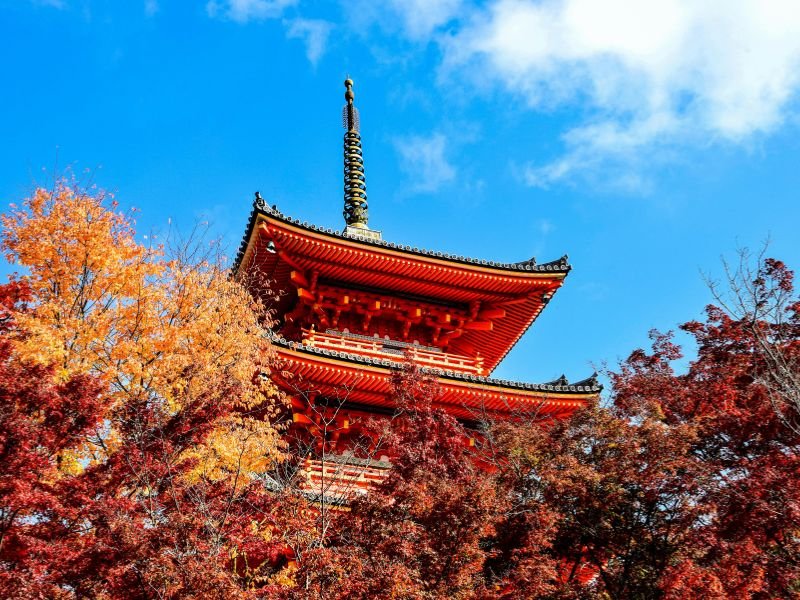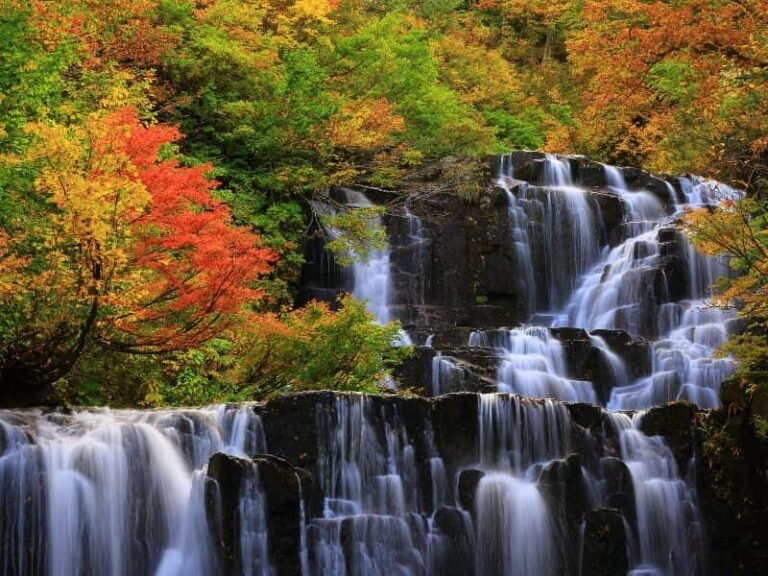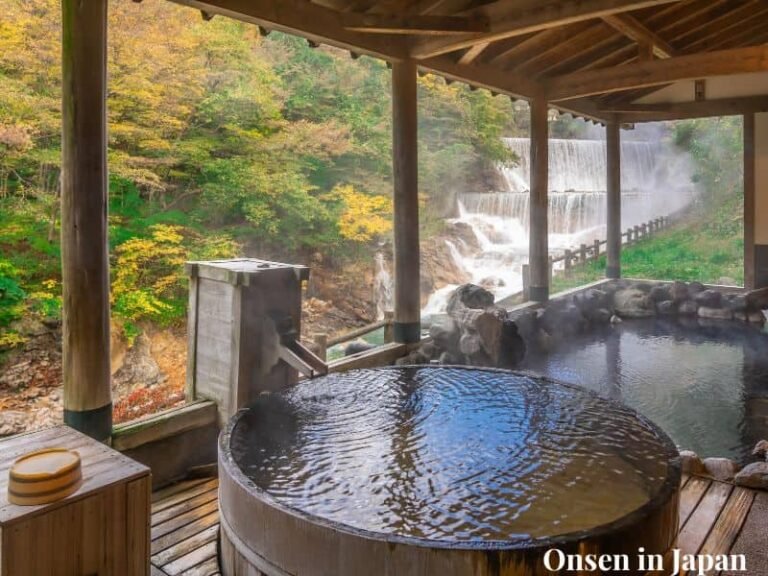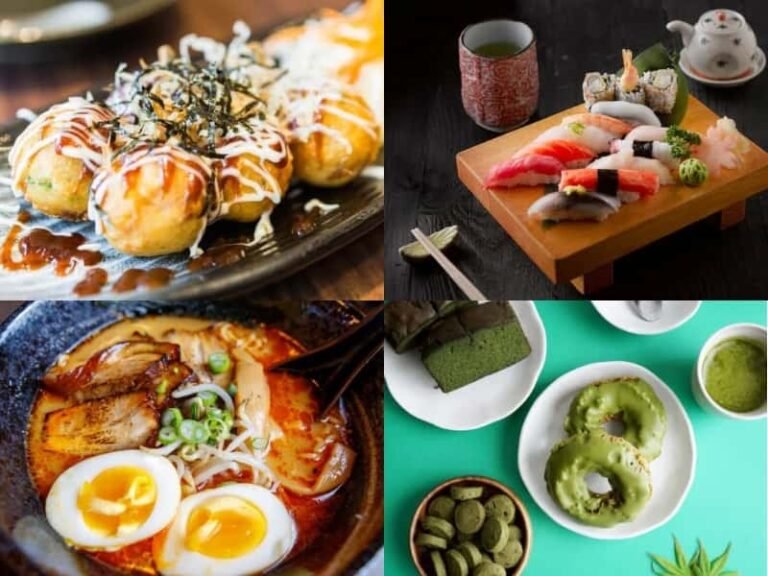Perfect 7-day Japan Fall Foliage Itinerary (Kansai area): Kyoto, Nara, Osaka & More (2025 Guide)
Planning the perfect autumn trip to Japan?
Fall foliage season (called “koyo 紅葉” in Japanese) transforms Japan into a breathtaking canvas of reds, oranges, and golds. Whether you’re dreaming of temple hopping in Kyoto or exploring the diverse landscapes in the Kansai area, I’ve got you covered with this perfect 7-day Japan fall foliage itinerary that will make your autumn Japan adventure unforgettable.
Japan’s autumn season typically runs from late October through early December, with peak foliage times varying by region and elevation.
When Is The Best Time to See Fall Foliage in Western Japan?

The timing of peak autumn colors varies slightly depending on the region and elevation, but here’s a general guide for Western Japan:
Mid to late November is typically the best time to see fall colors at their peak. Some temples with higher elevation start changing a bit earlier.
Pro tip: The Japanese Meteorological Agency and local tourism websites update foliage forecasts (紅葉予報) each fall. Checking the forecast 1–2 weeks before your trip can help fine-tune your itinerary
7 Days Japan Fall Foliage Itinerary
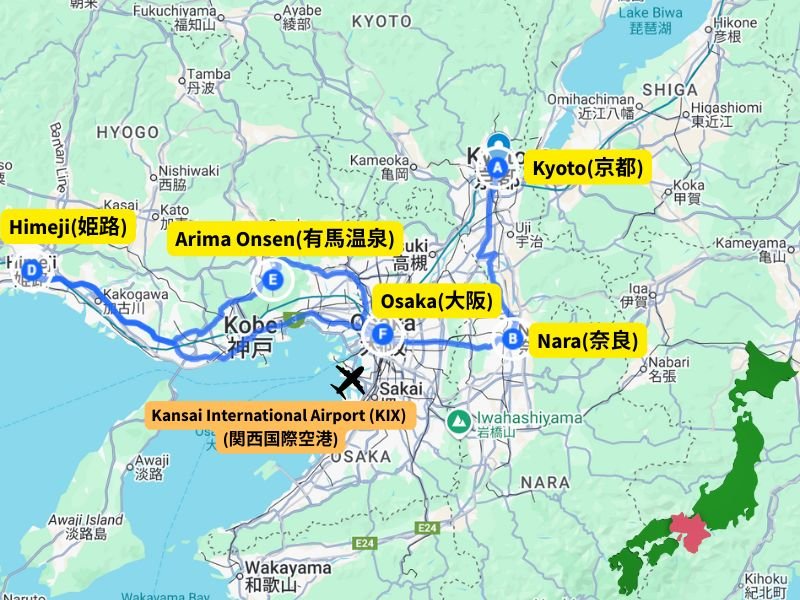
Over View By day
Day 1: Kyoto’s most iconic temples with stunning evening illuminations (Kyoto)
Day 2: Northern Kyoto’s unique foliage and famous Eikan-do Temple (Kyoto)
Day 3: Eastern Kyoto highlights including the Philosopher’s Path (Kyoto)
Day 4: Arashiyama’s bamboo groves and western temple treasures (Kyoto)
Day 5: Cultural day trip to deer-filled Nara with ancient temples (Nara)
Day 6: Osaka’s urban autumn colors and city exploration (Osaka)
Day 7: Himeji Castle’s golden ginkgo trees and Arima Onsen relaxation (Hyogo (Himeji))
Day 1: Iconic Temples & Evening Illuminations
Start your autumn adventure in Kyoto, where ancient temples frame some of Japan’s most photographed fall foliage scenes.
Tofuku-ji Temple (東福寺)
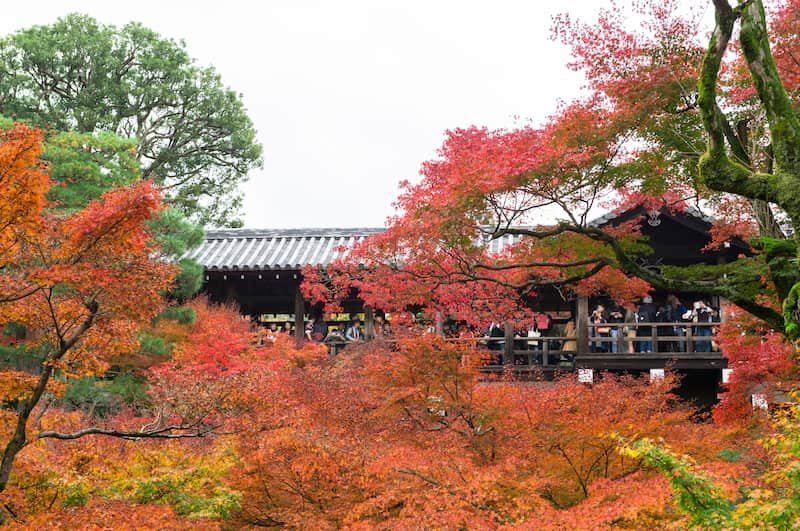
Begin early at Tofuku-ji, famous for its three historic bridges offering different perspectives of the autumn colors.
The Garyu-kyo (臥雲橋), Tsuten-kyo (通天橋), and Engetsu-kyo (偃月橋) bridges provide incredible vantage points where you’ll see waves of red maple leaves flowing like a crimson river through the temple valley.
Kiyomizu-dera Temple (清水寺)

Next, head to Kyoto’s most iconic temple, Kiyomizu-dera temple(清水寺). The famous wooden stage (kiyomizu-no-butai 清水の舞台) extends 13 meters above the hillside, offering panoramic views over a sea of autumn colors.
The surrounding Higashiyama district also bursts with fall hues, making the entire walk up to the temple a visual feast.
Kōdai-ji Temple (高台寺)
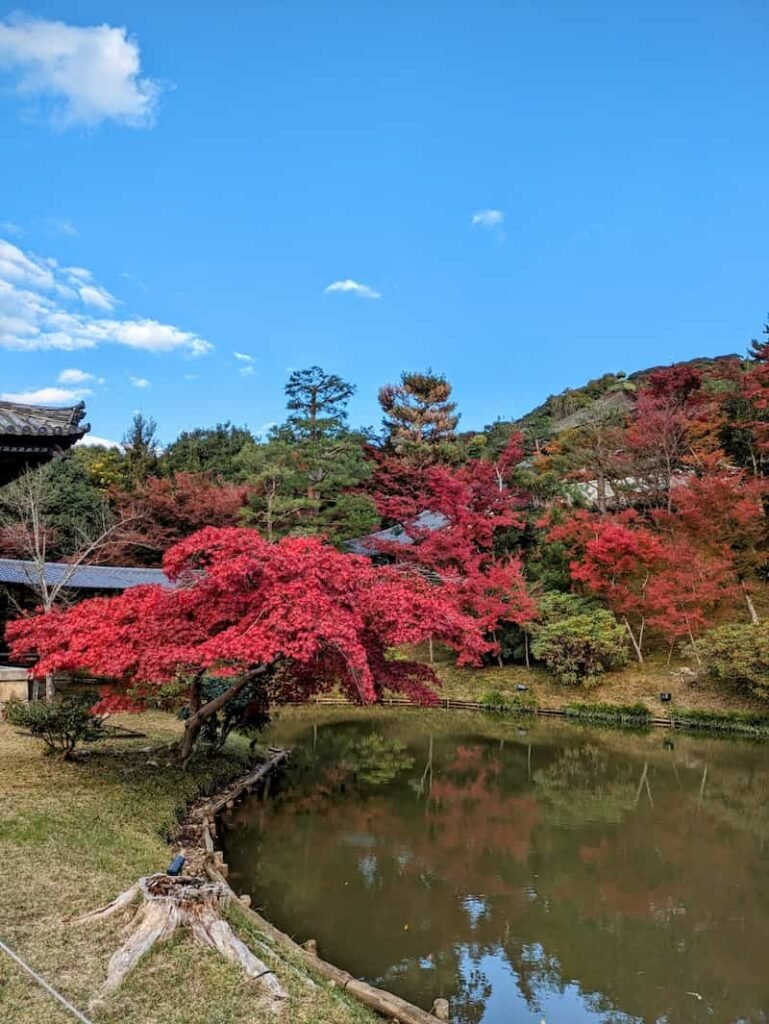
As evening approaches, experience one of Kyoto’s most magical autumn traditions.
Kōdai-ji’s special illumination events run from late October to early December, where carefully placed lights transform the temple gardens into an otherworldly landscape of glowing maples and bamboo groves reflected in mirror-like ponds.
To-ji Temple (東寺)
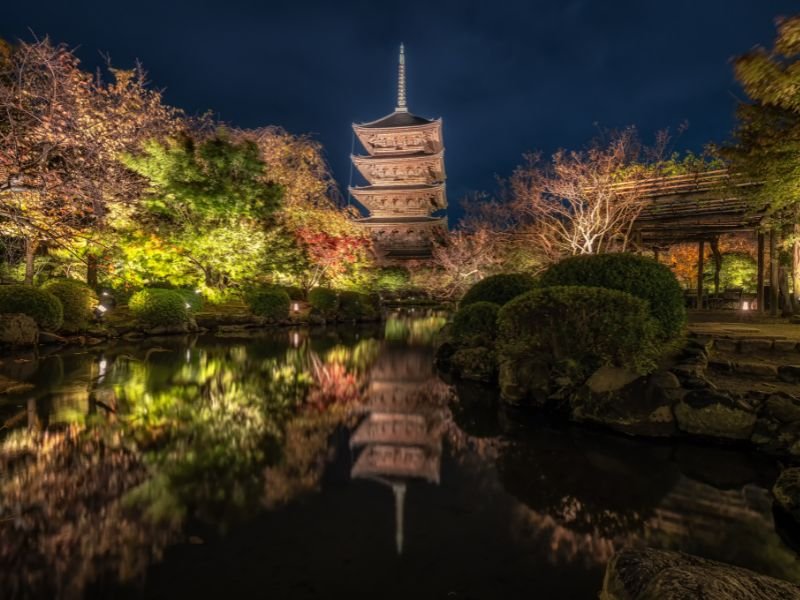
End your day at To-ji, where the five-story pagoda creates dramatic silhouettes against the autumn sky. The temple’s autumn illuminations provide a serene conclusion to your first day of temple hopping.
Day 2: Northern Kyoto & Unique Foliage
Eikan-do Zenrin-ji Temple (永観堂)
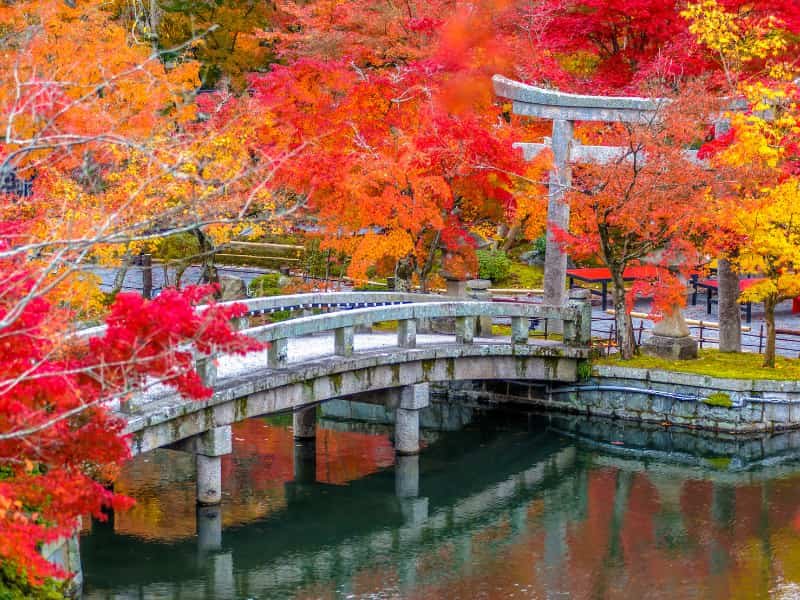
Eikan-do, nicknamed “Autumn Leaf Temple” and considered one of Kyoto’s absolute must-see fall foliage destinations.
This temple is legendary among locals for having some of the most intense and varied fall colors in all of Japan. The temple’s multiple levels and winding paths create countless photo opportunities as you climb through different elevation zones, each with its own unique autumn palette.
Nanzen-ji Temple(南禅寺) and the Philosopher’s Path(哲学の道)
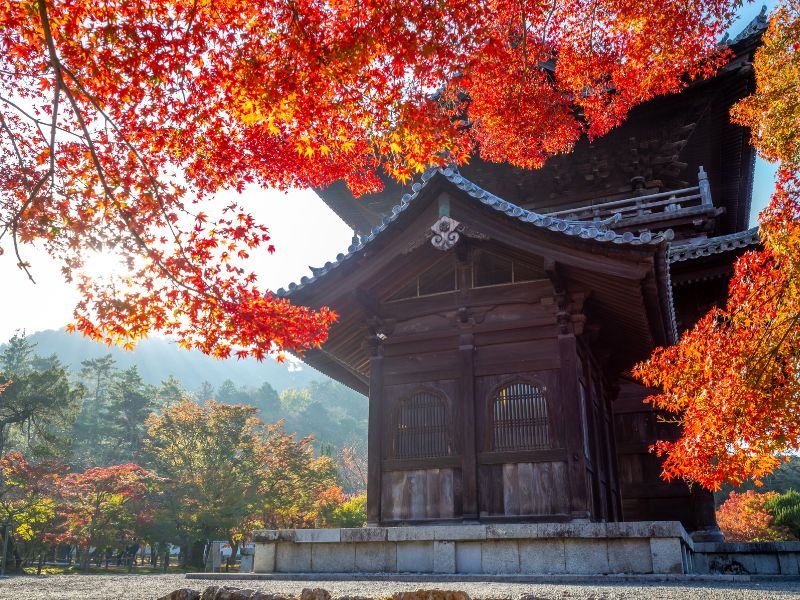
Walk the famous Philosopher’s Path (Tetsugaku-no-michi), a peaceful stone walkway following a canal lined with hundreds of trees that transform into golden tunnels during autumn. The path connects several temples and leads to Nanzen-ji, where the massive Sanmon gate(三門) frames spectacular mountain and foliage views.
The aqueduct at Nanzen-ji creates a unique backdrop where ancient Roman-style arches contrast beautifully with traditional Japanese autumn scenery – a photographer’s dream combination.
Heian Shrine Garden(平安神宮)
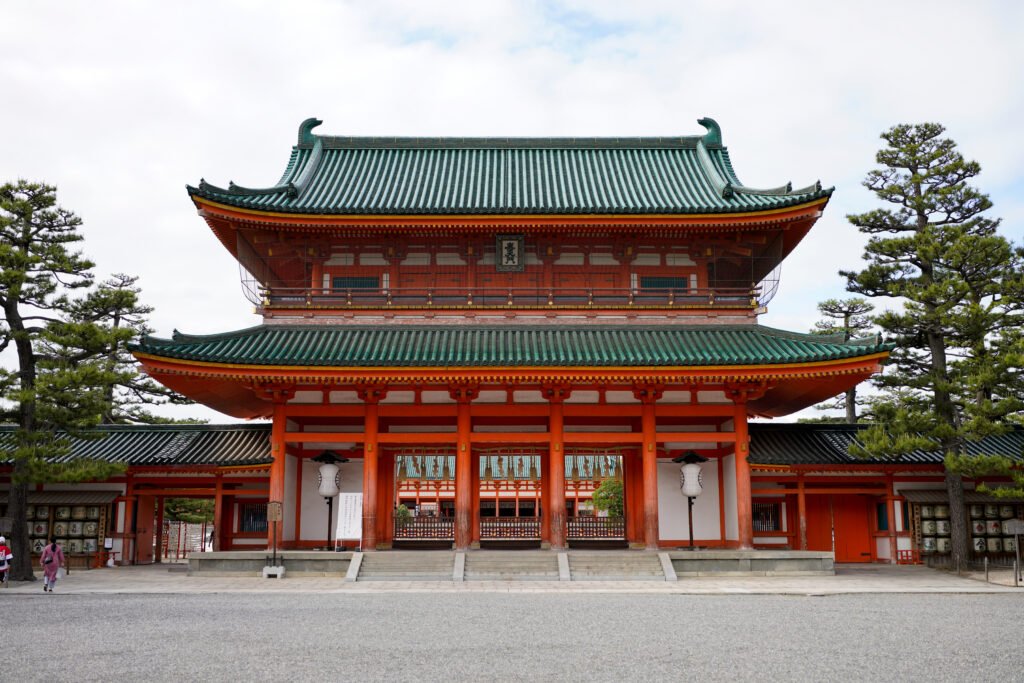
Spend your afternoon in the meticulously designed gardens of Heian Shrine. The large pond garden reflects the surrounding autumn colors like a mirror, creating double the visual impact. The garden’s careful landscaping ensures color throughout the fall season, with different areas peaking at different times, so you’re guaranteed spectacular views whenever you visit.
Day 3: Arashiyama & West Kyoto
Tenryu-ji Temple(天龍寺)
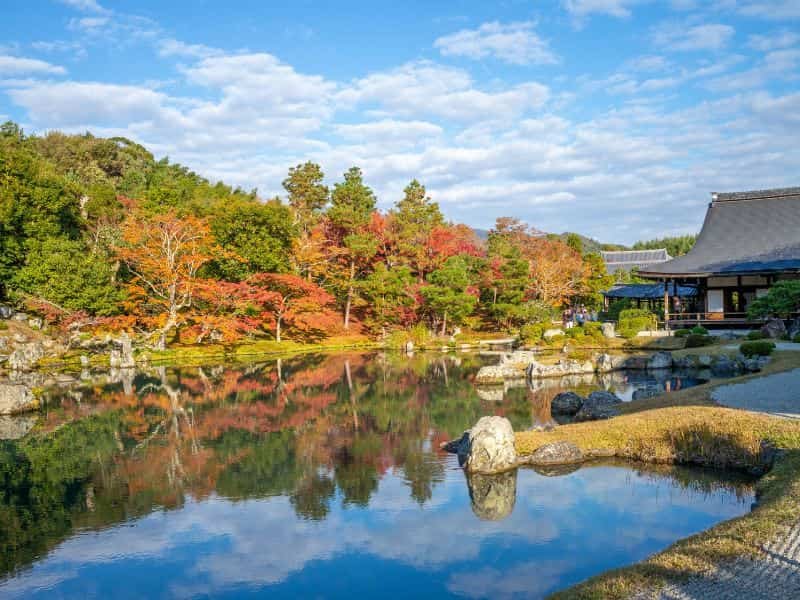
Arashiyama offers a completely different autumn experience from Kyoto’s eastern temples.
Start at Tenryu-ji, a UNESCO World Heritage site where the temple’s borrowed scenery technique incorporates the surrounding mountains into the garden design. The contrast between the green bamboo and fiery autumn maples creates an unforgettable visual experience.
Bamboo Grove(竹林の小径)
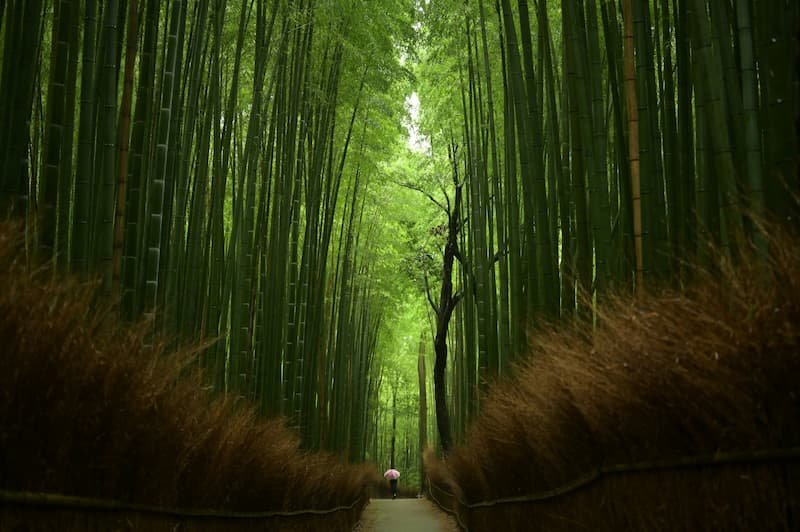
Walk through the famous Bamboo Grove afterward, where thousands of towering bamboo stalks create a green cathedral that filters the autumn sunlight into an ethereal glow.
The sound of bamboo swaying in the wind adds an auditory dimension to this magical experience.
Okochi Sanso Villa(大河内山荘庭園)
Okochi Sanso Villa is a peaceful garden with panoramic views, winding garden paths, and matcha tea included with admission.
Jojakko-ji Temple (常寂光寺)
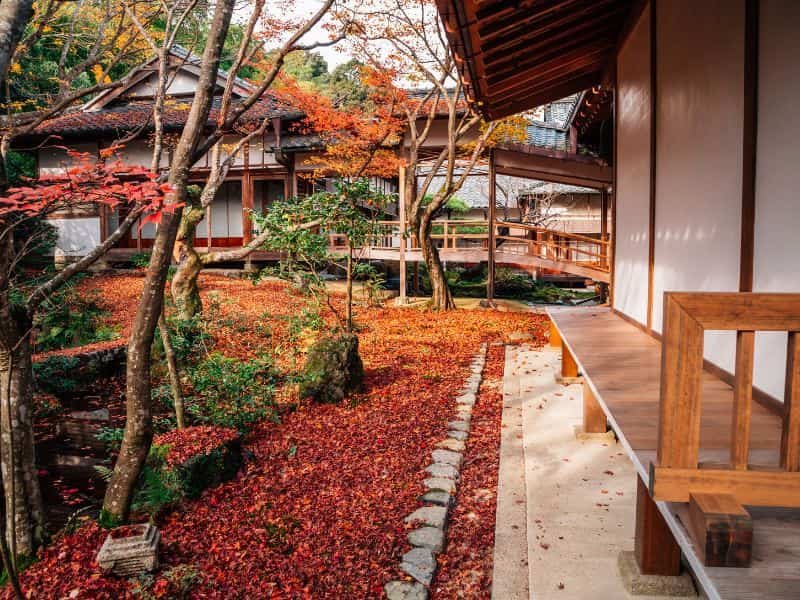
Jojakko-ji Temple is a lesser-known temple with mossy steps, quiet charm, and a great view over Kyoto—especially pretty in fall.
Togetsukyo Bridge (渡月橋)
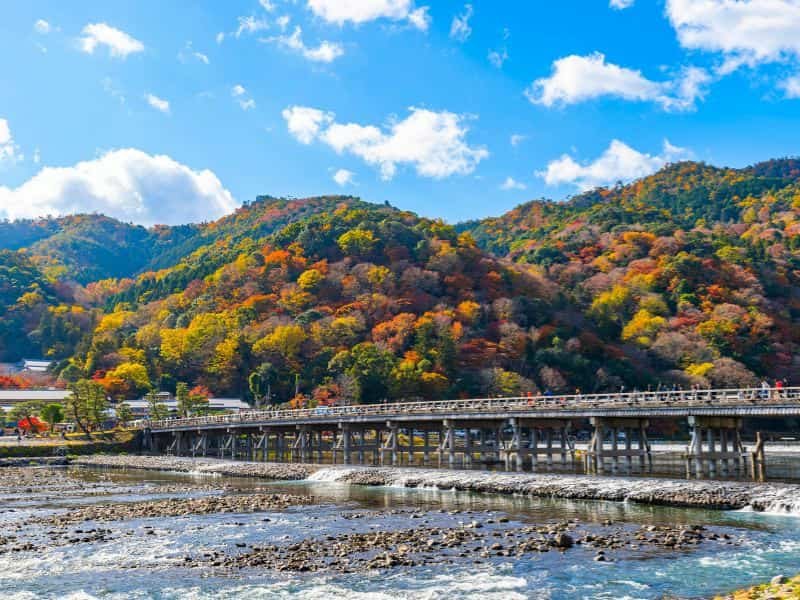
End the day with sunset views from the iconic Togetsukyo Bridge, where the Katsura River reflects the surrounding autumn mountains. This is one of Arashiyama’s most photographed spots, especially beautiful when the evening light makes the autumn colors glow like fire
Day 4: Nara Day Trip – Fall Colors & Friendly Deer
A short train ride brings you to Nara, Japan’s first capital, known for its ancient temples and deer that roam freely in the parks.
Travel to Nara (~45 minutes)
Take the special Aoniyoshi train (あをによし) if available – this luxury tourist train makes the journey part of the experience with comfortable seating and large windows perfect for viewing the countryside autumn colors.
Nara Park(奈良公園)
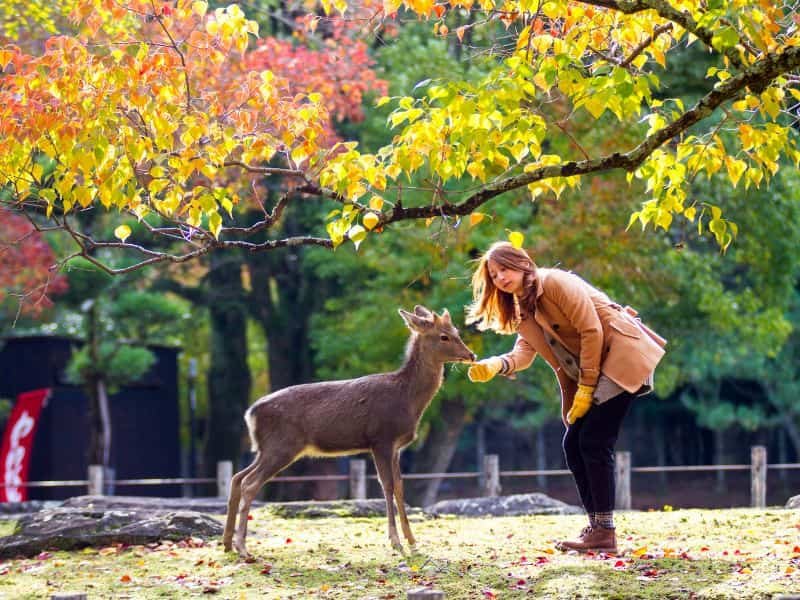
Nara Park is a spacious park where you can see deer mingling among vibrant trees. A favorite photo spot!
Todai-ji Temple(東大寺)
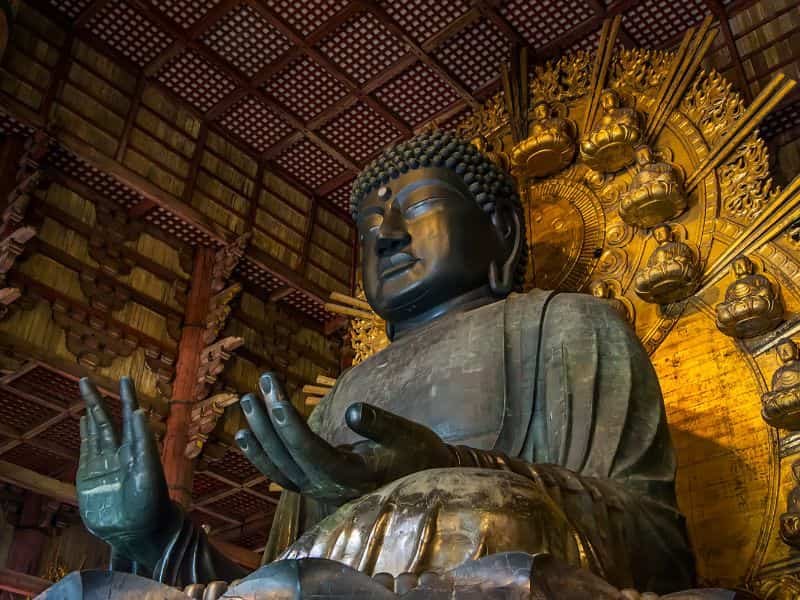
Todaiji is Home to Japan’s largest bronze Buddha statue and a massive wooden hall—surrounded by autumn colors.
Kasuga Taisha Shrine (春日大社)
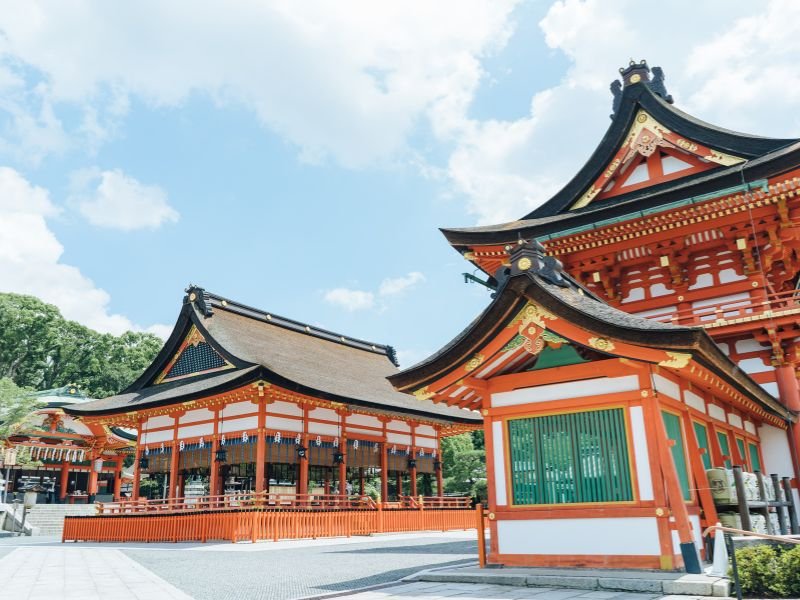
Kasuga Taisha Shrine is a mystical shrine with thousands of stone lanterns, tucked into a forest of maple and ginkgo trees.
Optional Extended Nara Experience
For the adventurous, consider visiting Shoryaku-ji (正暦寺), Tanzan-jinja (談山神社), or Hase-dera (長谷寺) for some of Nara Prefecture’s most spectacular but less crowded autumn viewing spots.
Day 5: Osaka Foliage and City Exploration
Osaka is a dynamic city where you can experience fall foliage, delicious street food, and lively urban life all in one day.
Minoo Park(箕面公園)
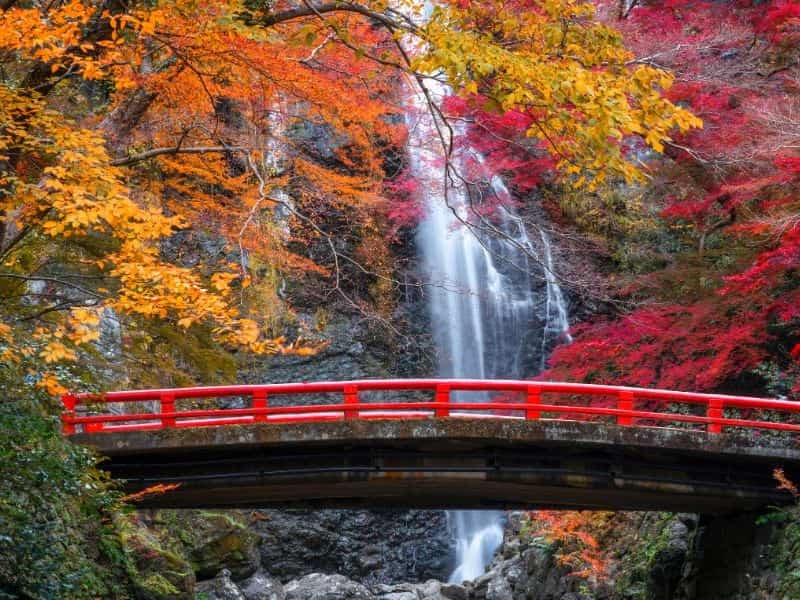
Start early at Minoo Park, famous for its 33-meter waterfall surrounded by fiery maple forests.
The hiking trail to the waterfall becomes a tunnel of autumn colors, and you can try momiji tempuraもみじ天ぷら (fried maple leaves) – a local autumn specialty that’s both Instagram-worthy and surprisingly delicious! The park offers some of the most accessible mountain autumn viewing near any major Japanese city.
Osaka Castle Park(大阪城公園)

The Osaka castle grounds offer urban autumn beauty with over 300 cherry trees that turn brilliant yellow and orange in fall.
The contrast between the reconstructed castle and autumn colors creates distinctly Japanese photo opportunities. The park’s wide spaces also make it perfect for picnicking among the fall foliage.
Optional Adventure
Katsuo-ji Temple – A colorful temple known for its thousands of lucky daruma dolls and vibrant trees.
CupNoodles Museum (Ikeda) – A fun, hands-on experience where you can create your own cup noodle.
(More details for CupNoodles Museum in my blog: “8 Best Factory Tours in Japan for Curious Travelers”)
Evening in Osaka
Head to Umeda Sky Building for panoramic city views or explore Dotonbori(道頓堀) for local eats and neon lights.
Day 6: Himeji Castle(姫路城) to Arima Onsen(有馬温泉)
This day blends history and relaxation—starting at Japan’s most famous castle and ending with a traditional onsen experience.
Himeji Castle (~1 hour from Osaka/Kyoto)
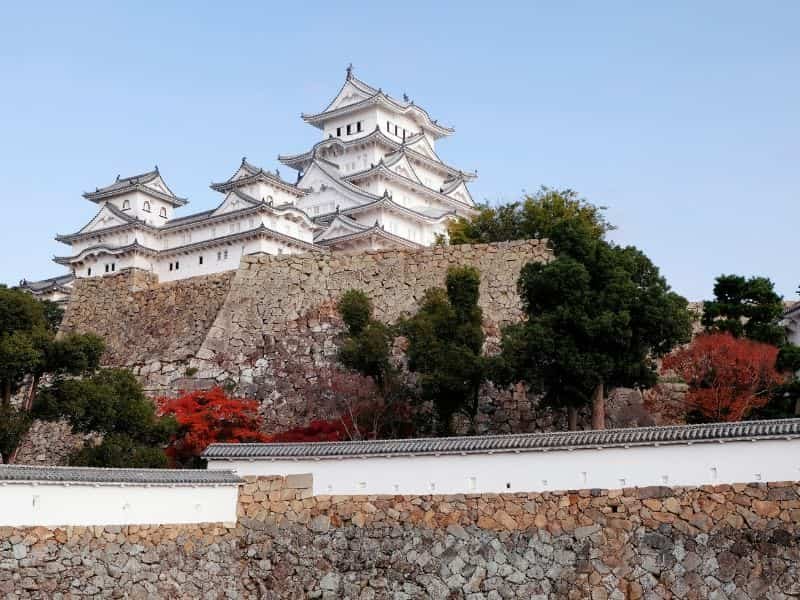
Himeji Castle‘s Nickname is the “White Heron Castle,” Himeji is stunning in any season, but fall brings golden ginkgo trees to its grounds.
Koko-en Garden(好古園)

Koko-en Garden is a beautiful Japanese garden right next to the Himeji castle, divided into nine themed areas with seasonal plants.
Stay in Arima Onsen有馬温泉 (Onsen Ryokan Experience)
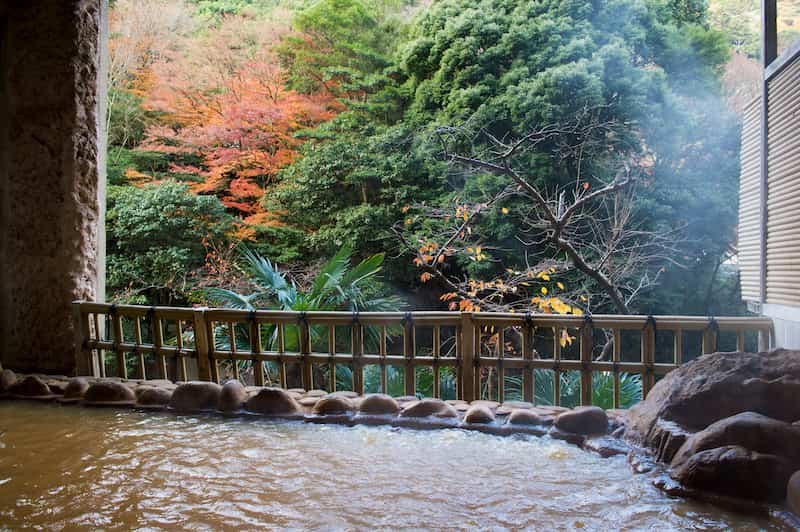
End your day at a traditional ryokan where you can soak in mineral-rich waters while surrounded by mountain autumn colors.
This 1,300-year-old hot spring town offers the perfect blend of cultural tradition and natural beauty. The town’s two famous spring types – kinsen (golden springs) and ginsen (silver springs) – provide therapeutic benefits that are especially welcome after days of walking.
The ryokan experience includes traditional kaiseki dinner featuring seasonal autumn ingredients, sleeping on tatami mats, and waking up to misty mountain views painted in fall colors.
👉 First time visiting an onsen? Don’t worry! Check out my detailed guide: The Ultimate Guide to Onsen in Japan (2025): Culture & Helpful Travel Tips – for everything you need to know about onsen etiquette, types of baths, and how to make the most of your experience.
Day 7: Kobe & Departure
Mount Rokko (Rokko Mountain Ropeway)
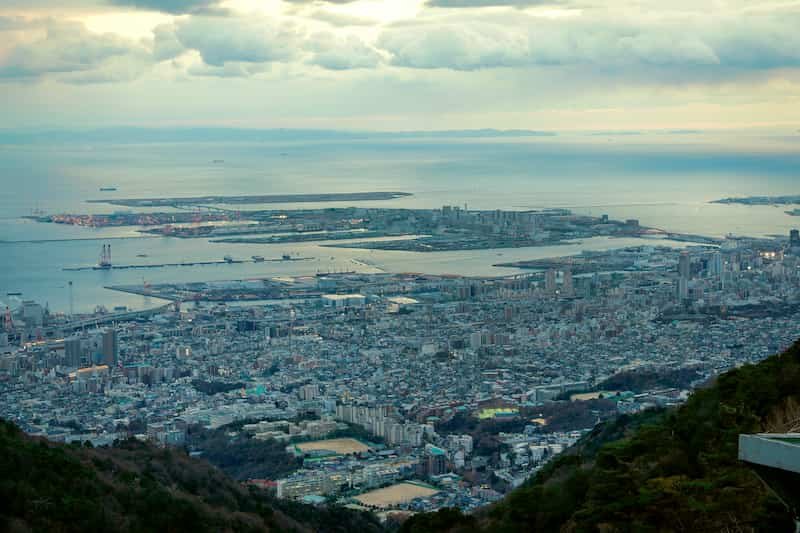
Start your final day with breathtaking panoramic views from Mount Rokko via the scenic ropeway. The ropeway journey up the mountain provides constantly changing views of Kobe, Osaka Bay, and the surrounding autumn-colored mountains. From the summit, you can see the entire Kansai region spread out below, with the autumn colors creating a patchwork across the landscape.
The ropeway itself is an experience – as you glide up the mountainside, you’ll pass through different elevation zones of autumn color, from the golden ginkgo trees at the base to the deeper reds and oranges of the mountain maples higher up.
You can choose a cable car too. Enjoy!
Optional: Kobe Town Sightseeing
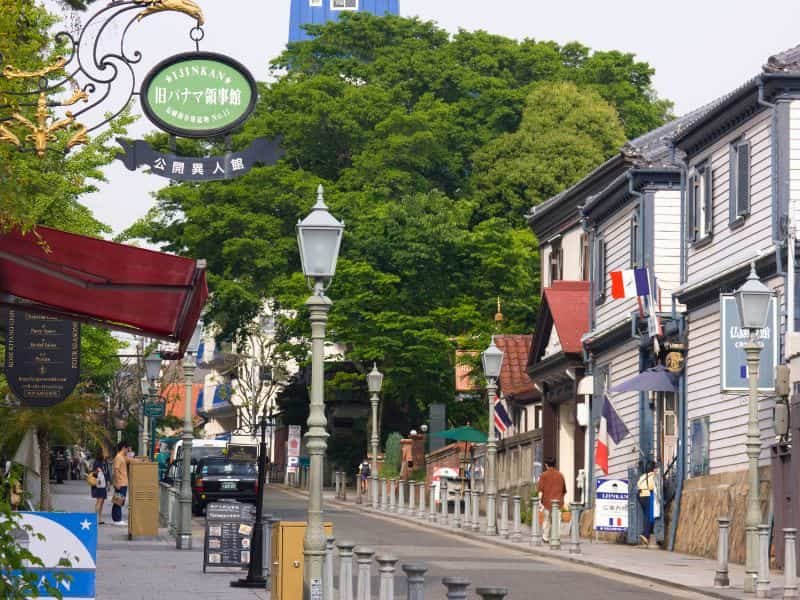
If you have time, explore Kobe’s charming downtown areas. The historic Kitano foreign district features Western-style houses with autumn gardens, while the waterfront areas offer views of ships against the autumn-colored mountains.
Kobe’s famous beef makes for an incredible farewell lunch if your departure schedule allows.
Departure: Head to Kansai Airport (KIX) or your next destination.
Bonus: Extend Your Trip By Train
If you have more time or a JR Pass, consider these train-accessible add-ons:
- Kinosaki Onsen – A storybook onsen town with 7 public bathhouses and canal-side maples.
- Hiroshima & Miyajima – Visit Peace Park and enjoy fiery foliage at Momijidani Park on the island.
- Kurashiki (Okayama) – Edo-era canals and white-walled merchant houses with gentle fall color.
- Fukuoka (Hakata) – Stroll Ohori Park and Dazaifu Tenmangu Shrine while sampling tonkotsu ramen.
If you’re visiting Japan in autumn, the Kansai area is a fantastic place to start. With a mix of cultural landmarks, beautiful nature, and hidden gems, this itinerary will let you enjoy the season at your own pace — with plenty of photo-worthy moments along the way.
Happy leaf-peeping!
